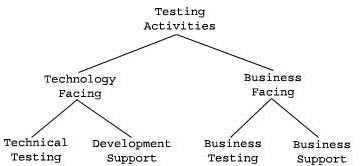Brian Marick’s series on Agile Testing Directions begins with a test matrix that describes testing activities as “Business Facing”, “Technology Facing”, “Support Programming” and “Critique Product”. This resonated with me, but it wasn’t until he pointed out that in my pair work with developers I did both Business Facing and Technology Facing activities that this seemed to click. I think this matrix he has developed provides testers with a common language to identify and communicate these activities.
I recently did presentations to business stakeholders on testing activities in Agile projects. I’ve generally found it difficult to explain the testing activities I engage in to fellow testers, let alone business stakeholders. In one meeting, I thought of the test matrix and brought up the “Business Facing” testing and “Technology Facing” areas of testing while I was explaining how I test on Agile projects. People seemed to understand this, so I started working on it more.
I started thinking of the matrix rotated on its side with Technology Facing on the left and Business Facing on the right. Instead of “support programming”, I went with “support” to capture both areas. The “business support” would involve activities like setting up meetings with developers and business stakeholders after each development iteration to ensure that the working code is what the business expects, and to get people communicating. I also thought that business support would involve helping the business people with acceptance tests and things like that.
I initially thought of naming each quadrant of the matrix, but when explaining it to my wife Elizabeth, she said: “Why don’t you just put that in a tree diagram?” I did just that, and presented Agile Testing activities like this:
I felt that “technical testing” was a simple way to describe “technology-facing product critiques”, and “business testing” would describe “business-facing product critiques”. Keeping it simple seems to work well when communicating testing concepts to non-technical people.
I described some of the testing techniques in each area. For example, a technical testing activity I use involves collaboration with the developers to write tests that can be run in the absence of a user interface. This can involve adding tests to drive a layer of the application at the controller level. Once the developers make this area testable, we co-design and develop a test case. I can then own the test case and run it with different kinds of test data.
Under the programmer support activity, we can pair together to generate testing ideas. In a test-driven development environment, we can pair program to come up with tests that drive the code, or the tester can use a scripting language to write the tests for the developers.
Business people and technical people seemed to understand this tree diagram and the explanations I gave. I heard later that business stakeholders were starting to use this language in other contexts when they were talking about testing.
